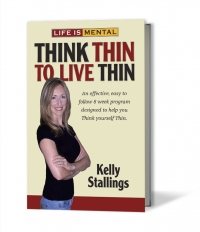Kelly Stallings Interview – Life is Mental: Think Thin to Live Thin
“Life is Mental: Think Thin to Live Thin”
Jasbina Ahluwalia interviews Kelly Stallings
Kelly Stallings is a licensed psychotherapist and the author of Life is Mental: Think Thin to Live Thin offering a simple solution for addressing the mental aspect of weight loss.
She has more than 14 years of experience working with people in group settings to create significant changes in their life including increased overall physical health.
Kelly is a native Texan and graduate of the University of Houston. She is active in several professional national and local associations including the National Association of Women Business Owners. The Federation of Houston Professional Women honored Kelly with the prestigious Woman of Excellence Award in 2008 for both her professional and community involvement.
_____
(4:46): Hello everyone and welcome to Intersections Match’s Talk Radio, a monthly holistic lifestyle show focused on the continual evolution into the best versions of our authentic selves. We and our guests discuss relationships and health and wellness, each of which contributes to meaningful and fulfilling lives.
This is Jasbina, your host. I’m a former practicing lawyer and the Founder of Intersections Match, the only elite national personalized matchmaking company focused on singles of South Asian descent nationwide in the US.
I’m very excited to welcome Kelly Stallings to our show tonight. Kelly is a licensed professional counselor with a master’s degree in counseling psychology. Kelly has more than 12 years of experience working with people in different settings to create significant changes in their life including increased overall physical health. Tonight, we will be discussing Kelly’s book, Life is Mental: Think Thin to Live Thin. Welcome, Kelly.
Kelly Stallings
(5:48): Hi, thank you for having me.
(5:51): It’s a pleasure to have you. As Intersection’s mission is holistic and includes personal empowerment and wellness coaching in consultation with a registered dietician, I’m fascinated by insights regarding proactively working towards health and wellness goals.
Kelly, before exploring the insights shared in your book, can you share with our listeners what prompted you to write this book in the first place?
Kelly Stallings
(6:14): I noticed that this was the missing piece in the marketplace for health and wellness and weight loss. Everyone commonly refers to the mental component of weight loss but there was no easy-to-follow solution out there. As a cognitive behavioral therapist, I had been teaching my formula to private clients for years. I realized that I could positively impact a lot of people by publishing a book and including the formula that I use with private clients so that everyone would have access to that and be able to integrate that into their existing weight management program.
(6:56): In your book, you write, “Changing your thinking and beliefs about your self-image in weight loss will create a strong, positive foundation for you as you work towards your weight goals. This foundation will assist you in facing challenges and succeeding.” Kelly, can you explain to our listeners what you mean by this?
Kelly Stallings
(7:18): At the core of our belief system, that is like our autopilot. Think about those quick snap decisions that we make during daily life, whether it’s to make the exercise class, step into the gym before or after work or if we choose to skip it. All of those little decisions reflect back to who we believe we are.
It reflects our self-image, our belief about ourselves. If we don’t have really high self-esteem or belief about ourselves, we might not really treat ourselves the way that we should. If we make that change at the foundational level and focus on improving our self-esteem and self-image, then we will take better care of ourselves and treat ourselves as the precious beings that we are naturally, without effort.
(8:10): In your book, you explain that thinking yourself thin starts with identifying the reasons to lose weight. Tell us about that.
Kelly Stallings
(8:19): If we’re not clear on why we’re losing weight, we’re not going to stick to it, especially if the situation is one where the person has carried extra weight for many years or has a full life history of that. To really make a significant change in our thinking and lifestyle, we really have to be motivated. That motivation comes from our reasons why.
For some people, it might be a crucial health concern and recognizing that losing weight will increase their health and wellness and decrease the negative effects on their health. It will decrease the medical symptoms that they’ve been experiencing. Maybe it’s for a certain event coming up and they want to look a certain way in their clothes.
It really doesn’t matter what the reason is, as long as we’re clear on what the reason is as we get started with some sort of formal weight-loss plan. That’s what we’re going to lean on for the motivation to keep going through those challenges.
(9:24): During the rough spots, those reasons are really what’s going to anchor your efforts.
Kelly Stallings
(9:34): Exactly. I teach you how to use those reasons as a motivator and tool so that, when you hit those little challenges and rough patches where you might get off track for a short period of time, those reasons can help you get back on track quickly.
(9:56): These reasons are a really important starting point. In our wellness coaching, we ask our clients to maintain a daily food and activity log. I notice that your book, likewise, guides readers to complete what you call a daily food journal. Given your extensive counseling experience, share with our listeners the reasoning behind this.
Kelly Stallings
(10:18): It is significantly important to track your food. Like you mentioned, I have a daily food journal. It’s pretty well-rounded. We’re tracking a few more things than just simply food. At the core of it, it’s food. The reason for that is that it’s our human nature not to exactly remember everything that we’ve taken in for the day. It’s easy for us to minimize things and not remember the exact amount. That doesn’t really give us an accurate reflection of our daily food intake.
If you really want to change your lifestyle and you’re modifying your food intake so that you can have a more balanced meal or a lower calorie count on a regular basis, you have to track it. Recognizing where you’re starting helps you modify it so that you can get to where you want to be. If you don’t track it, you’re naturally going to minimize it and think that you’ve taken in fewer calories than you really have.
(11:22): You also find that having that record helps people to identify patterns in terms of what might be their pitfalls, certain times of the day or certain moods.
Kelly Stallings
(11:41): That’s how I ask people to use the food journal. I have a few extra boxes on my food journal because I want people to start recognizing the fact that we all have patterns. Once we recognize that we have patterns, it makes modifying and changing our lifestyle so much easier. Now we’re aware. We know it’s coming. We know that 2:00 is our sweet snack every day. It’s a lot easier to plan ahead and be proactive so that we do something different at 2:00 every day and not fall into that same routine. It’s really about creating awareness.
(12:16): You create awareness. Then you can get to the solution once you have that awareness. Your book has a section entitled Positivity is Thin Thinking. Can you share with our listeners what you mean by that?
Kelly Stallings
(12:32): Positivity is that mental attitude of optimism. If you think about it, the people who have an easier time managing their weight tend to be, generally speaking, a little bit more optimistic. They’re the folks who can get off track and get right back on track with their food plan. They can have a weekend where they attend a birthday party and a wedding. They’ve eaten all kinds of cake and food that they don’t normally eat.
That doesn’t crush them. That doesn’t devastate them. They start Monday as a new week and go right back to their regular eating plan. Even if they gained a pound or two, they’re going to lose it again because they go right back to their old pattern. Without that optimistic attitude then the person is more likely to start feeling like they’ve blown their diet.
They think, “I’ve gained a few pounds over the weekend. This is just horrible. There is no reason to eat healthy. I might as well just eat whatever I want for the next couple of weeks.” That weekend experience will turn into weeks or months of an experience for someone who isn’t as optimistic. Your attitude really helps you to be successful quicker.
(13:47): A positive mindset is really an asset in this journey that people are taking. Cravings are another pitfall. Cravings can be a stumbling block for many people seeking to enhance their health and wellness through weight loss. Can you share with us some of your great tips from your book for dealing with cravings?
Kelly Stallings
(14:21): You want to be able to identify a craving. You can determine whether or not you’re experiencing true hunger or a craving by where you’re feeling it. If you’re feeling hungry in your mouth, salivating because you’re thinking about a certain food item, that’s not true hunger. True hunger occurs below the neck. It’s your stomach. When you start feeling hunger pains in your stomach, that’s true hunger.
First, you want to recognize if it’s a craving or true hunger. Once you recognize that you’re having cravings, you want to look at what you’re eating. If you’re not getting enough nutrients in your food and you’re not eating enough live foods so that you can feed your body what it really needs, you might need a vitamin supplement. Sometimes we crave things, like chocolate, because it has properties that are similar to what we need to get in our food.
It’s not that we need all the sugar attached to that. Sometimes a craving is nothing more than your body desiring something that it’s deficient in. Those are the first things that I tell people to watch.
Other times, when people label things as cravings, it could be cue-controlled eating. I might go out with a certain girlfriend to a restaurant and I have the worst food ever and eat and drink too much. It’s always with this one particular girlfriend. We have this habit of the same place that we go and the things that we order that I really don’t want to eat or drink. That’s cue control.
That’s a habit that I’ve created with my girlfriend. That’s not really a craving. It feels like it because, the minute we get together, I’m automatically preparing myself for what I know is going to happen next. If that’s the case, you want to be proactive. You want to create a new pattern with your friend. It might be a certain television show that you like to watch at home. It might be a certain family experience. Maybe when your entire family gets together, you do the same thing every time and it’s not so healthy.
It doesn’t have to be any one thing. Look at the patterns in your life. When you recognize that you’re having this cue-controlled eating experience, awareness is key. Now you can take control and make some changes. If you can’t change your environment then change your reaction. Make a different decision. If you know that you absolutely have to be in that environment, you’re going to go to the same restaurant because it’s a group decision and you can’t sway their decision, then you take control of yourself and your decision making.
You make a different decision when you’re there. If there are no healthy options, you might think about eating some healthy snacks before you meet your family or friends. That way, you’re not tempted to eat while you’re there. You can still make healthy decisions, even if your environment is not healthy. You just have to take control.
(17:22): That’s such an empowering mindset to have. You just mentioned a number of solutions. Your book has a section entitled Reprogram Yourself to Think Thin. I love this quote. I’d love to have you expand on it. The quote is, “Your thoughts drive your behavior, your reactions to events, your awareness of opportunity and your decision.” It’s a great segue from what we were just talking about. Can you share with our listeners what you mean by that?
Kelly Stallings
(18:04): Again, the key is awareness and control. Take control of your life. Take control of your decision making. Be aware of your habits so that you can create new, healthier habits. That is the key. The daily food journal is what allows you to start identifying these habits so that you can start making a change. You track the habit in your daily food journal so that you can see things changing and that you’re making new strides.
One of the things that I tell people is to give yourself time to truly make a change. The biggest challenge for people making any kind of change in their life is that they are impatient. They don’t feel like they get the results as quick as they should. I like to remind people that it took months and years to become the person that you are today with the thoughts you think and the beliefs that you have.
To change that, you need to invest the time. It could be weeks or months, maybe even years. If you give it that attention and you’re truly determined to make a change, within weeks, you will start feeling a difference. Within months, you’ll start realizing that it’s now become part of who you are. It’s only after years that you won’t think about it anymore because it truly is how you are. In the beginning, you have to stick to it. You have to keep repeating the behavior that you want to see in your life. Repetition is what causes change.
(19:33): Repetition is what causes change. Your book has a whole section on practical strategies for challenges. Can you share one or two of those tips with our listeners?
Kelly Stallings
(19:49): There are a couple of things. People tend to be the most interested in my tips for eating out at restaurants. We eat out a lot now. That’s part of American culture. We don’t seem to eat at home as much as we used to years ago. If you’re with your family and it’s a very comfortable setting, set up a new rule with your family where you share your food. The portion sizes in restaurants are very large.
They’re serving us on dishes that used to be considered serving dishes back in the fifties. Our plates are becoming bigger to accommodate these big entrée sizes. When everyone at your table has a huge plate of food, you don’t really recognize just how big it is. You might think, “That looks like a big portion,” but you don’t realize just how big it is because everyone at the table has monster plates.
If you decide as a family that you want healthier portions, you can strategize how you order. A couple of entrees might be shared between family members. Then you will eat healthier. That will naturally reduce your portion sizes. You’re going to ask the waitress to bring extra plates. Typically, when they bring extra plates, they bring you smaller plates to accommodate sharing food. That is absolutely one of the best strategies, especially for a family or many people eating out together.
If you’re by yourself or if you’re meeting someone for dinner and you’re not really comfortable sharing food, you have two other options. My favorite other option is to ask the waiter or waitress to box up half of the meal before they bring it to the table. When they do that, the chef still wants a nice presentation on the table. When they take half of your portion and box it up, they will put it on a more normal-sized plate.
They’re still going to have a nice presentation, even though it’s half of the portion size. You will still have a nice presentation but you’re not going to try to avoid eating all of that food. People are visual. What we see, we eat. For most people, we don’t recognize when we’re full because we’re eating so fast.
The second option if you’re eating out alone or with someone that you can’t share food with is to contaminate half of the food on your plate. This is effective, however, it doesn’t really look so nice. If you’re in a professional setting, it doesn’t come across nicely. It can seem a little weird. It is still effective, nonetheless. If you have a big entrée that comes to the table and, for whatever reason, you don’t get it boxed up, manually split each of the portions on your plate.
Scoot it to the side and contaminate it with sugar, salt and pepper or whatever else is on the table. The contamination is so that you don’t eat it. That’s a really important part. It goes back to the idea that we’re all visual eaters. If that food is just scooted to the side and we’re used to eating our whole plate of food, it’s pretty easy to convince yourself and rationalize why you should keep eating, even though you’ve scooted it to the other side of your plate. If you contaminate it, that won’t happen. You will have to want that food pretty bad to eat it with sugar all over it.
(23:19): You’re talking about putting ketchup on the pancakes. Your book guides readers to take 100% responsibility for their weight. Tell us what you mean by that.
Kelly Stallings
(23:35): What I find in working with people is that very few people want to take 100% responsibility for their life. Most people come in and tell me why it is someone else’s fault that they are overweight. It’s their family’s fault. It’s their relative’s fault. It’s their spouse’s fault. The fast food is at every corner and it’s their fault. It’s that whole concept of blaming everyone else and not looking within.
I think it’s so important that everyone recognizes that we are the way we are because of the choices we make. If we don’t like where we’re at this moment, it’s as easy as making new choices and then repeating new choices so that we will see change in our lives. Very few things are going to change overnight, if anything. Weight certainly is not one of them. We need to have a commitment that we’re going to make changes and then be patient so that we can see the changes in our body as well.
(24:46): It’s coming from a place of empowerment. I love the idea that we’re making choices. We are the ones making choices. We can change the choices that we’re making in the present, for the future. Can you share with our listeners one or two of your favorite success stories from your years of counseling?
Kelly Stallings
(25:18): Yes. The one that always comes to my mind personally motivates me. That’s always such a good feeling, to have a client really motivate me. I was working with a woman who had a pretty sedentary lifestyle and career. Over the years, she gained weight. She had several kids, a family and a routine that did not support weight loss. As she started my training and started implementing small changes over time, she noticed that she was losing weight and seeing benefits, so she continued the training. The training in the book is set up to be scheduled over an eight-week period. I tell people that, if you have really aggressive weight-loss goals, just go back through the book again. Repetition is a good thing.
You can just keep repeating the book. It will keep reinforcing what you learn and expand on it. As she started making these small changes, she started incorporating positive activities into her lifestyle. She would take her kids to the park. At the park, she could be more active. She could still watch her kids while they played or did homework after school. She could get some activity in the park by walking.
Walking turned into jogging, which turned into her aspiration to complete a marathon. She’s not training to complete a marathon. This started with a sedentary lifestyle. Now, not only has she changed, but her positive change affected her entire family in a very positive way. Now her children are going to be used to having physical activity on a regular basis and connecting that physical activity with fun family time.
Not only are they going to have these great memories of, “Remember when we all went to the park with mom and what we did?” but now they will be more apt to do that with their family as adults because that’s how they were raised. That’s what they know. They may not even realize that it was done for health. As a kid, you don’t always understand why things are happening. You just know they’re happening.
It won’t matter because they have this great, positive programming built in to their little minds because of her decision to make a change. That is one of the most profound changes that I’ve seen. If you can enlist other people as support, even if they don’t recognize that they’re there to support you, we are more apt to continue positive activities in a group setting.
The majority of us enjoy social experience. That social experience is something that we will continue and repeat easily. If her social experience was with her children at the park and that was a positive experience, everyone felt good and happy and it was enjoyable, that’s something that she will be able to repeat. If she doesn’t feel like going, her kids are going to be there to prod her and push her.
She will have this motivation in-house without even realizing it. We can inspire the people around us in some small way so that they’re somehow part of our positive change. That wasn’t planned. She didn’t tell her kids to do that. That’s just the natural evolution of her plan. Everyone will have more success if they utilize that strategy as well.
(29:01): I love that story. There was an impact across generations. What I really love about it is that she found something that she could do on a regular basis that was already part of her life. She made that a more value-added experience for herself and her loved ones as well without departing greatly from what she was already doing. The thought of being able to fit it into what you already have in your life can be helpful as we are all living very busy lives.
I really appreciate you sharing your thoughts with us, Kelly. They’ve been really insightful and interesting. Is there any last thought or take-home message that you’d like to leave our listeners with?
Kelly Stallings
(30:01): I think I just want to mention repetition. Repetition equals change. The minute that you recognize you’re feeling impatient and it’s not happening fast enough, remind yourself that it’s normal. We’re an instant gratification culture. It’s okay to be patient. The patient strategy with weight loss means that it’s going to be long term. It’s a life change. It’s okay if it takes a few more weeks or months. This is for life.
(30:40): I’d like to thank Kelly Stallings for joining us today. It’s been a pleasure. If you’d like to learn more about the insights that Kelly has been sharing with us today, her book is entitled Life is Mental: Think Thin to Live Thin.
In case you joined us late or would like to share this show with people in your life, I’d like to remind you that today’s radio show will be archived and available as a podcast on Intersections Match’s website, which is www.IntersectionsMatch.com. I can be reached at jasbina@intersectionsmatch.com. I appreciate you hanging out with us. Do email me with topics you’d like discussed in future shows. Make sure to join us for next month’s show.
_____
What do you think?
Would you like to add to the insights shared by Kelly Stallings? Share your thoughts in the comments below.
_____





